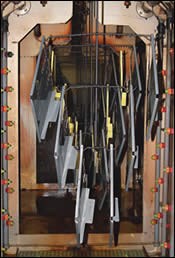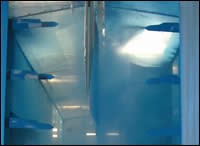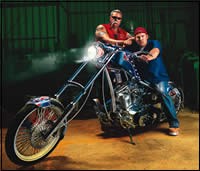True Blue
At Miller Electric Manufacturing Company, the world’s largest manufacturer of arc welding and cutting equipment, a quality finish not only defines the look of the company’s products—it is instrumental in their durability and performance...
Most welders can spot a piece of Miller Electric’s equipment from 100 yards away.
It’s the blue that gives it away, really. You see, nearly all of Miller Electric’s products are coated in a bold, blue color that has come to represent the company and its products much in the same way that United Parcel Service (UPS) is associated with brown or the way that Nike has been identified by its “swoosh.” In fact, the color has become so much a part of the company’s identity that it has an entire product line named “Big Blue.”
Welcome! You’ve unlocked premium content.
Founded in 1929, Miller Electric Manufacturing Company, Appleton, WI, has become the world’s leading manufacturer of arc welding and cutting equipment for metalworking, construction, maintenance and other industrial applications. Since 1993, it has been a business unit of Illinois Tool Works.
The first welding equipment manufacturer to comply with the tough new ISO 9001-2000 standard, Miller Electric has a reputation for exceptional quality, especially with its paint performance. The company's level of quality is based on very stringent criteria, including a neutral salt spray (NSS) performance specification of 850 hours.
Miller employs both liquid paint and powder coatings at its Appleton facility. Painted products represent about 90% of Miller Electric’s components business and many are used in harsh, industrial environments where good corrosion inhibition is needed to protect equipment. Parts bearing the company’s unofficial trademark blue color are coated with PPG powder coatings in one of two automatic spray booths.
Enhancing Pretreatment
Pretreatment is vital for all of Miller’s powder coated, dipped and hand wet-sprayed components consisting of sheet metal, sheet aluminum and weldments.
For years, Miller had relied on a five-stage carbon steel system for its pretreatment needs. Although there had been no environmental, health or safety issues with the old washer, salt spray performance had declined by about 25% in two years; the first stage was being dumped too frequently, wasting water and chemicals; and the sealer stage was difficult to control and was falling out every two weeks.
In 2000, Miller Electric retired the 21-year old system and invested in a new pretreatment washer to provide a seven-stage cleaning and conversion coating process with a final RO halo. The new system added two rinse stages to improve the new cleaning process:
Stage 1: Alkaline cleaner
Stage 2: Rinse
Stage 3: Rinse
Stage 4: Iron Phosphate Coating
Stage 5: Rinse
Stage 6: Non-chrome sealer
Stage 7: Rinse
Fresh RO Halo
Although the new washer system was well designed and maintained, the consistency and quality of the pretreatment performance was still not acceptable to Miller Electric. Various system tests were performed, but no answer was found to explain the source of the problem.
After learning about GE Infrastructure Water & Process Technologies during a Chemical Coaters Association tour of a metal fabrication company, Miller Electric approached the company and asked them for assistance, spawning a cooperative business relationship.
After nearly 10 months of research to analyze all aspects of the operation, Water & Process Technologies traced the solution to the need for more effective chemical treatment. To meet and exceed Miller Electric’s needs, it proposed a new chemistry program based on Kleen™ 132 alkaline cleaner, Permatreat™ 306A iron phosphate conversion coating and Phosgard™ 800 HP non-chrome sealer.
In addition to the new chemistry, Water & Process Technologies recommended automating the pretreatment process with AccuTrak™ controllers for a more accurate chemical feed. Miller also opted to use a software called InfoCalc™ for SPC analysis and data collection and reporting. It took 30 days to introduce the new pretreatment chemistry once GE was selected to set up a weekend changeover.
The Water & Process Technologies' chemical technology immediately began producing very consistent iron phosphate coating weights. It also consistently exceeded the neutral salt spray performance standard. The quality control process at Miller Electric is designed to verify performance standards on a regular basis, and the new process has enabled the company to outperform its standards every time.
Says Carl Van Helvoirt, project engineer at Miller Electric, “Automation and data processing are giving us tighter control and better information on the quality of each monitored stage. The system operation now requires less attention and we expect to realize some cost savings in 2004.”
In addition to performance improvements, Miller has also identified benefits from a pollution control standpoint. With the old chemistry and washer system, the company had been dumping its cleaner stage every six months, generating a lot of sludge in the process. With the new technology, the cleaner stage is being dumped once every eight months. Cleaning and waste disposal are easier with the new phosphate stage, as well.
Water & Process Technologies and Miller Electric continue to cooperate as partners in a close working relationship founded on trust and centered around a mutual interest in quality, productivity and profitability. It involves joint planning and problem solving, shared goals, project documentation and a commitment to continuous improvement through new technologies and the best possible products and services.
Matt Roeser, a district representative for Water & Process Technologies, attributes the success of the partnership to Miller Electric’s employees, and the lengths that the company goes to in order to keep good people. “The tenure at Miller is phenomenal,” he says. “The people who work at Miller stay at Miller. As a consequence, they know the system like the back of their hand. You can clearly see that the people who understand the technology and who are passionate about what they do drive this partnership.”
Related Content
Products Finishing Reveals 2024 Qualifying Top Shops
PF reveals the qualifying shops in its annual Top Shops Benchmarking Survey — a program designed to offer shops insights into their overall performance in the industry.
Read MoreReduced, Reused and Recycled Powder Coatings Are the Future
They say necessity is the mother of invention, and with millions of pounds of powder coating going into landfills a year, these two companies have found novel approaches to dealing with this waste stream.
Read MoreSelecting the Right Outdoor-Durable Powder Coating
The powder coating industry offers an array of chemistries to provide an excellent match to the manufacturer’s expectations for outdoor durability.
Read MoreAn Altruistic Growth Strategy Puts People First
Professional Plating emphasizes investing in its team and fostering a supportive environment on the shop floor.
Read MoreRead Next
A ‘Clean’ Agenda Offers Unique Presentations in Chicago
The 2024 Parts Cleaning Conference, co-located with the International Manufacturing Technology Show, includes presentations by several speakers who are new to the conference and topics that have not been covered in past editions of this event.
Read MoreEpisode 45: An Interview with Chandler Mancuso, MacDermid Envio Solutions
Chandler Mancuso, technical director with MacDermid Envio discusses updating your wastewater treatment system and implementing materials recycling solutions to increase efficiencies, control costs and reduce environmental impact.
Read MoreEducation Bringing Cleaning to Machining
Debuting new speakers and cleaning technology content during this half-day workshop co-located with IMTS 2024.
Read More


























